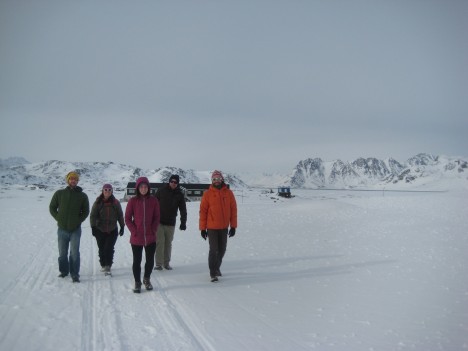Hello! This is Olivia and I’ll be writing about the hydrology work we are doing this year on the Greenland ice sheet. A few years back some scientists on our team discovered liquid water inside the ice sheet. They partnered with us to study the water in greater depth.
We think that the snow melts at the surface, percolates down through the snow and firn, and pools inside the ice. The water fills up the air space between the ice crystals, creating an aquifer inside the ice sheet that we think behaves similarly to aquifers found on land. The hydrology that we are doing this season is basically a “groundwater” hydrology study, except that in this case it is an “ice-sheet-water” hydrology study. We will try to test our ideas about how the aquifer behaves and understand what that means for the ice sheet and sea level rise more broadly.
To answer these questions, we will collect measurements of how deep the water is and how much pressure it has to determine where the water is entering and exiting the aquifer. We will test how quickly the water travels through the firn and also collect water samples. The chemistry of the water will tell us information about how long the water has been inside the ice sheet. All of this information will give us a much better idea of how the aquifer is filling up, and where the water is going, and how quickly it moves. This kind of information is important for understanding how ice sheet melt relates to sea level rise. If the aquifer is storing water for long periods of time, than it may have less of an immediate impact on sea level rise. However, what happens if it fills up and suddenly drains quickly? Or maybe it is constantly draining?
To make our measurements and collect our samples, we had to do a lot of work to modify traditional groundwater hydrology tools and instruments to work at very cold temperatures. Groundwater hydrologists often use piezometers, long pipes that have a small opening at the bottom to let water in, to access the aquifer they are investigating. To install a piezometer into the ground, you can pound it in. To install our piezometer into the ice, we have developed a piezometer with a heated tip that can melt through the hard ice layers.
Another challenge we face is that many of the samples we collect cannot freeze, and yet we expect the temperature at our field site to often be below freezing. When we collect these samples, we completely fill the sample bottle so there is no air space in the bottle. We do this so that we can analyze gasses that are dissolved in the water back in the lab. If these samples froze, the water would expand and break the bottle, ruining the sample. To prevent these samples from freezing, we have modified several coolers to be extra-insulated and to have special heaters inside them.
It has been quite the learning experience to take all of our groundwater hydrology work to such a different environment! But this is part of what makes the science exciting. We get to try something that has never been done before.
Tags: cryosphere, drilling, Greenland, Greenland Aquifer Expedition 2015, ice





good read. can’t wait to hear about your results as they come in throughout the summer.
nice work on tweaking your equipment to meet the task, sounds challenging to say the least.
I’m very interested to hear what you learn about where/how the aquifer drains. Also, if the aquifer(s) drained at some constant rate, how much sea level rise do these massive slush aquifers commit us too? Of course my question assumes that they never refreeze in a permanent way?
AC,
Your questions are great and just what we are trying to answer. From our first field work in the area we tried to constrain the amount of water in the aquifer which we believe to be equivalent to 0.16 inches (0.4 mm) of sea level rise. Remember this water is still on land so it is not contributing to sea level yet and the yearly sea level rise today is ~3 mm per year. Here is some more info on results so far. https://www.nasa.gov/content/goddard/enormous-aquifer-discovered-under-greenland-ice-sheet/#.VVzM00YjL2k
Aren’t you folks lucky ?!! Really look forward to keeping up with your posts, All the best, Vincent Day
Thanks for reading Vincent! We all feel very lucky to get to do this research.
There are some who feel the Great Lakes should becmoe something of a reservoir for the south. To date the Great Lake States and their counterpart Canadian provinces have banded to resist the initiative.It’s a good idea to keep a wary eye on the state of Mississippi River navigation.